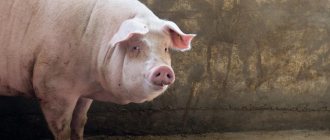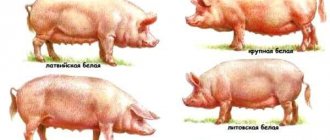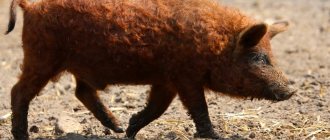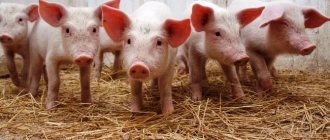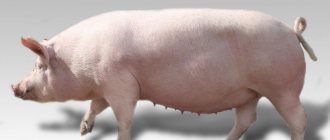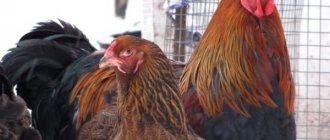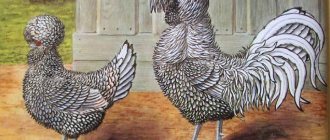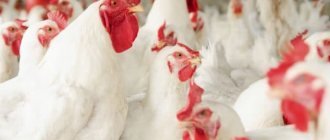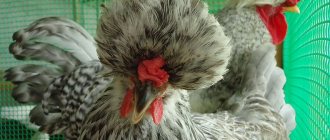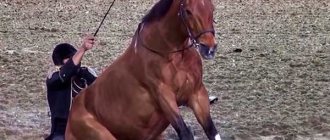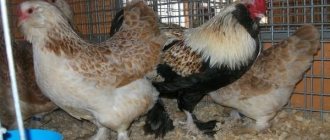- General characteristics of the animal
- Areas where breeding is practiced
- Optimus breeding
First, let's look at a little general information, and only then we'll get to breeding Optimus pigs and look at their photos. In many countries of the former CIS they like to breed pigs of two categories. The first category includes meat animals, for example, the large white breed or the equally well-known Landrace and others. The second category includes this universal breed, or as they are called meat-fat pigs, breeds of such pigs: large black, Duroc and others.
Photo of a sow and piglets of the Optimus breed
Naturally, each breed has its own differences, pros and cons, as well as different body types. It is by the type of body and its composition that the directions of a particular pig are distinguished. The direction usually speaks for itself. Accordingly, if the breed is meat, then the animal produces more meat than lard and vice versa.
Meat pigs are characterized by a long body with a lightweight front part, usually not too heavy hams, as well as a shallow chest depth. The greasy breed is distinguished by a wide body, a rather weighty front part, large hams and a noticeably deeper chest. Universal animals are something between the greasy category and the meat category.
As for the pigs called Optimus, the subspecies is more of a meat type and is not suitable for raising an animal for lard. The photo below can perfectly characterize the animal. But their meat is of excellent quality, and it is precisely because of this characteristic that they are often used for crossing and improving the meat performance of other subspecies, as well as for improving commercial production and breeding new hybrids.
General characteristics of the breed
Experts speak very positively about pigs of the Optimus breed. This breed is distinguished by excellent immunity, remarkable endurance and a unique balance between the amount of meat and growth. Optimus sows produce homogeneous offspring and demonstrate impeccable maternal instinct. Optimus boars are ideal as inseminators for both natural and artificial insemination. The offspring obtained from representatives of this breed are distinguished by excellent vitality, even when the piglets are separated from their mother early.
General external characteristics and photos of Optimus breed pigs
Optimus pigs are light in color and have excellent health. Studying the appearance of the animal, it can be noted that it has:
- Wide and strong body;
- A long and deep body without the “interceptions” in the area of the shoulder blades that are characteristic of many breeds;
- Superbly developed hams;
- Short and elastic pasterns;
- Relatively small limbs;
- Strong hooves;
- Thick, but at the same time elastic skin with a complete absence of folds;
- Smooth and thick bristles covering the entire body of the pig.
Optimus pigs
Breeding areas for Optimus pigs
The Optimus breed is distributed throughout almost the entire territory of the Russian Federation. The excellent reputation of breeding individuals gives them the opportunity to settle on farms and serve as an improver for local pigs that do not have such outstanding meat qualities.
Productivity
Optimus pigs are deservedly one of the most productive meat breeds. They demonstrate excellent performance in terms of clean meat yield per carcass. Due to the fact that Optimus have well-developed muscles (especially in the ham area), thin bones, and a small head, the slaughter meat yield often reaches 80%.
Fertility
Sows of the Optimus breed are classified as having multiple births. During one farrowing, up to 11 piglets are born. At the same time, the pig has excellent milk production, which allows babies to gain weight quite quickly. A six-month-old piglet often weighs about 100 kg.
Optimuses are completely unsuitable for producing high-quality lard. The thickness of the back fat of an adult individual can reach 15 mm, which indicates that the lard productivity indicator is quite low.
Features of breeding Optimus pigs
Optimus pigs cannot be called capricious in terms of maintenance. They have sufficient endurance, strong immunity, resistance to many diseases, unpretentiousness to a selected diet, as well as a friendly and flexible character. The only serious whim of Optimus can be called vulnerability to drafts. This is due to the fact that the fat layer of pigs is very thin and cannot be an ideal protection against drafts. If we exclude this factor, then keeping Optimus pigs will bring extremely positive results.
In addition, as already mentioned, it is reasonable to use the Optimus boar as an improver of the meat qualities of local pig breeds.
First, let's look at a little general information, and only then we'll get to breeding Optimus pigs and look at their photos. In many countries of the former CIS they like to breed pigs of two categories. The first category includes meat animals, for example, the large white breed or the equally well-known Landrace and others. The second category includes this universal breed, or as they are called meat-fat pigs, breeds of such pigs: large black, Duroc and others.
Naturally, each breed has its own differences, pros and cons, as well as different body types. It is by the type of body and its composition that the directions of a particular pig are distinguished. The direction usually speaks for itself. Accordingly, if the breed is meat, then the animal produces more meat than lard and vice versa.
Meat pigs are characterized by a long body with a lightweight front part, usually not too heavy hams, as well as a shallow chest depth. The greasy breed is distinguished by a wide body, a rather weighty front part, large hams and a noticeably deeper chest. Universal animals are something between the greasy category and the meat category.
Content
Bred in the temperate maritime climate of England, the breed is not resistant to frost, cold, and drafts. In addition, in the southern regions, these animals may suffer from burns in the summer, as their skin is white and sensitive. Therefore, before getting Yorkshires, it is necessary to thoroughly think through the correct layout of the pigsty project and balance the diet. These animals graze well, and succulent food can take up a third of their diet.
This breed of pig requires very careful care and maintenance.
Feeding
Pigs are omnivores. Therefore, they are suitable for feeding both plant and animal food. Protein is especially important in the diet. Low levels may result in decreased productivity. Carbohydrates are needed for the formation of fat, and since the Yorkshire breed is a meat breed, their content in the diet should be minimized. For feeding use:
Concentrated feed. This is the grain of barley, corn, oats. They are well digested in the body (up to 90%), but are poor in calcium. Barley is mostly used to feed suckling sows. Formulated feeds also include bran and homemade feed. The latter contains the ratio of nutrients necessary for animals;
- Juicy feed. These are potatoes, beets, carrots and more. Potatoes in the diet can be about 20%. It is used boiled. The beets are fed with the tops, having previously been chopped. It is advisable to include carrots in the diet of pregnant and lactating sows, as well as small piglets;
- Green food. Yorkshire pigs graze well on meadows. You can include clover, peas, quinoa, and nettle in your diet. In summer, such feeds form the main diet with the addition of dirt, bran or mixed feed;
- Animal feed. This group includes milk, skimmed milk, meat and fish waste. Dairy products have a good effect on the quality of meat, so it is advisable to include them in the diet of young animals for fattening;
- Additional feed. Mushrooms, acorns, various food waste.
Approximate diet for pigs.
Pig pens
Pig pens are built taking into account the characteristics of this breed, as well as the microclimate required for them:
- The internal parts of the walls up to a height of 1 meter are covered with boards. This insulates the room;
- The height of the pigsty must be at least 2 meters. If the roof is pitched, then the rear part is 1.5 meters;
- The area for keeping a sow is at least 5 square meters, for young animals up to four;
- The walls of the machine are made of thick planed boards. The location for the den must exactly match the size of the animal. It is separated from the rest of the pigsty by a strip that is attached to the floor;
- A trough is installed at the front wall. They can be made of different materials. Both wooden and metal. And even asbestos, which can be made by sawing the pipe lengthwise and sealing the sides with boards. The trough should accommodate a single portion of feed;
- In a pigsty, you can arrange a den for piglets in the back of the pen next to the sow's den.
The average area of a pigsty containing a Yorkshire pig must be at least 5 sq.m.
General characteristics of the animal
The Optimus breed comes from England and was bred by English breeders. Optimus are often confused with the Yorkshire pig, because they are very similar in visual characteristics. Many who have at least once encountered this animal leave positive reviews about this subspecies. This is not surprising; pigs in this category have an excellent immune system and very good endurance. But these are not all the positive features of pigs; they also have an exceptional balance, which no other subspecies has, between weight gain and meat.
The Optimus pig has exceptional maternal instincts, and breeds homogeneous offspring. Boars, in turn, are excellent inseminators. Moreover, this applies to both natural and artificial insemination. Animals have very good adaptability to life. This even applies to small piglets that are taken away from their mother's nipple very early.
The external characteristics of the animal can be seen in the photos presented in the article. The skin color of the subspecies is usually light in color, the body of pigs is quite strong and wide, the body of the category is long and deep, without the so-called “interceptions” that most other pigs have in the area of the shoulder blades. The hams are very well developed, the limbs are placed correctly, but relatively small, the hooves are powerful and strong. The skin is thick, but surprisingly does not have folds. Although the skin is thick, it is also quite elastic. Pig's bristles are small and also light in color.
Flaws
After keeping these animals for a long time, negative aspects were identified when caring for them.
Requirements for climatic conditions
According to experts in their scientific videos, these farm animals do not adapt well to new weather and climate conditions, making the acclimatization process slow.
Due to the lack of fat, pigs are very sensitive to temperature changes, low and high temperatures. Piglets and adult pigs should be kept at a temperature range from -5°C to a maximum of 22°C. Ignoring this condition has a bad effect on the health and productivity of the breed, so it is recommended to insulate pigsties during the cold season and frequently ventilate them in extreme heat.
Dietary requirements
The second negative characteristic is the careful selection of feed mixtures, associated with pickiness towards individual food products. Pilets and Pietrain pigs have a very unusual gastrointestinal tract, which provokes a need for high-calorie food. Doctors recommend diluting the animal diet with vitamin and mineral supplements from time to time. Food waste, sugar beets, peas, soybeans, beans, corn, grain feed are easy enough to diversify your diet.
Piglets take a very long time and gain weight poorly. Even if you increase the number of meals, the gains will be insignificant. This factor does not depend on farmers, it is part of the genetics of this breed. But if you make an effort and increase the amount of foods containing protein, you can achieve the desired result. These include:
- waste from fish and dairy products;
- boiled potatoes with peel;
- raw root vegetables, peeled or in their original form;
- ground grain crops or feed.
If you feed the younger generation with oats, corn and legumes, you can ensure the children’s full development.
Not all Pietrain piglets survive birth. This is due to the low amount of milk produced by the sow. Research shows that it can feed a maximum of 6 babies.
Areas where breeding is practiced
Breeding of the breed covers almost the entire territory of Russia. Since the reputation of pigs is very good, this allows them to increasingly fill production and farms. In addition, the breed serves as an improvement for other types of pigs, whose productivity and meat indicators in general are not as luxurious as those of this tribe.
As for productivity, we can safely say that the breed is the most productive of all types of pigs with meat characteristics. These representatives have truly excellent performance in terms of pure meat productivity per carcass. All thanks to the physique of the subspecies. Since pigs have well-developed muscles, especially in the ham area, the subspecies has thin bones, and the size of the head is not very large, the meat yield from one carcass reaches and sometimes exceeds 80%. Photos of pig bodies are proof of this:
If we talk about the fertility of sows, then they and the breed as a whole are classified as prolific pigs. During one pregnancy, the uterus gives up to 11 babies. But also with all this, the pig has excellent milk production, this allows small piglets to gain body weight without problems and quite quickly. So, by the age of 6 months, piglets often grow to one hundredweight.
The disadvantage of the breed is that they are not at all suitable for lard production. But this is not strange, because the pig is aimed at meat. The thickness of the fat in the Optimus breed is approximately 15mm. Such indicators in pig farming are considered quite low and are not suitable for fat productivity.
Breeding pigs of “Hypor” genetics
Breed characteristics: Maternal line C (Large White breed)
When breeding Large White maternal line breeding pigs, the EuriBLUP method is used, it allows you to determine the breeding value of these animals. Breeding pigs of the Large White breed carry Meishan genes. When the line was developed in 1990, 8% of the Meishan genes were added to the French and English Large White breeds. This made it possible to combine high fertility and avoid the disadvantages of the Meishan breed's exterior. The development of the line was completed 20 years ago.
The main directions of selection in the breed:
- Litter size.
- Number of live born piglets.
- Preservation of the litter until weaning.
- Age at first mating.
- The number of piglets weaned from a sow during her lifetime.
- Interval between weaning and insemination.
- Maternal qualities.
- Weight gain while growing.
- Thickness of the spinal stud.
- The thickness of the muscle layer.
- Physical strength.
- Birth weight.
- Weaning weight.
- Lack of halothane gene.
- Some exterior features.
Maternal line D (Landrace)
When breeding Landrace maternal line breeding pigs, the EuriBLUP method is used - it allows you to determine the breeding value of these animals. The line originates from the Norwegian, Danish, Dutch and English Landraces. The development of the line was completed 30 years ago, and since then the line has been developing as a mother line.
The main directions of selection in the breed:
- Litter size.
- Number of live born piglets.
- Preservation of the litter until weaning.
- Age at first mating.
- The number of piglets weaned from a sow during her lifetime.
- Interval between weaning and insemination.
- Maternal qualities.
- Weight gain while growing.
- Thickness of the spinal stud.
- The thickness of the muscle layer.
- Physical strength.
- Birth weight.
- Weaning weight.
- Lack of halothane gene.
- Some exterior features.
Paternal line DUR Duroc (Magnus)
Breeding Duroc (Magnus) pigs come from Canadian and American Duroc animals. Duroc was developed to serve the high quality product segment. Breeding this breed is beneficial to those market segments for which the quality of the meat is of paramount importance: marbling, water-holding capacity, and color of the meat. Duroc pigs are used to produce high-quality hams.
Main directions of selection:
- Industry leader in growth rate.
- Vitality and physical strength.
- High average daily gain and high weight at slaughter.
- Carcass quality.
- Appearance, uniformity of appearance within a population.
- Meat quality (marbling, color, water-holding capacity).
- Thickness of the spinal stud.
- The thickness of the muscle layer.
- Percentage of meat in the carcass.
- Feed consumption and conversion.
- Some exterior features.
- Lack of halothane gene.
Paternal line H16 Pietrain (Maxter)
Pietrain (Maxter) is one of the leading terminal boars of the Pietrain breed in Europe. Distinctive characteristics of the breed are low feed conversion, rapid growth, high uniformity of the population, lean carcass, absence of the stress gene (HAL). This boar is ideal for producing animals with increased yield of lean meat.
The main directions of selection in the breed:
- Lack of halothane gene.
- Physical strength and endurance.
- Uniformity within a population.
- Weight gain while growing.
- Thickness of the spinal stud.
- The thickness of the muscle layer.
- Percentage of meat in the carcass.
- Feed consumption and conversion.
- Some exterior features.
Optimus breeding
The breed is quite calm and not capricious in terms of maintenance. Great endurance, strong health, a powerful immune system, the animal’s body is resistant to many diseases, there are no special dietary restrictions, the character is calm and friendly. The only disadvantage when breeding the breed is its weakness to drafts. This is all due to the small fat layer; it is quite thin and therefore does not provide sufficient protection from drafts. But if you do not take this factor into account, then breeding the Optimus breed will only be enough and will bring positive emotions and results.
As previously mentioned, boars of this breed are very good for crossing with other species in order to improve the meat performance of animals.
Pig farming is considered one of the largest industries in our country. Pork meat always finds its buyers. The most popular breeds of pigs for meat . These are the breeds of piglets that breeders keep on their farms. And it is these best breeds of pigs that end up in our stores for use in cooking.
Feeding
Pietrain is a breed of pig that can be kept on farms using two main technologies: meat; meat-greasy. In the first case, the costs will be approximately 2-2.5 feed units per 1 kg of weight gain, in the second - 3-3.4 feed units.
Two-month-old Pietrain piglets are suitable for the meat method. When using this fattening technology, pigs are given plenty of food. But the main emphasis is on proteins.
Animals should also receive food that improves the taste of meat: dairy products, greens, root vegetables. The sources of proteins with this technology are grains and animal feed.
In addition, the diet of pigs includes minerals necessary for their body - chalk (25-30 g), table salt (10-30 g), phosphorus (8-10 g).
Sometimes farmers also use regular aspirin to speed up weight gain in animals. It should be added in an amount of 1 g per 50 kg of feed. —
Meat and fat technology
This technique is practically no different from the previous one. Meat from pigs fed using this technology is intended mainly for the production of long-term storage products - hams, raw smoked sausages, loins, etc.
Meat and fat fattening is conventionally divided into two periods. At the first stage, piglets receive feed that promotes weight gain as quickly as possible. The basis of the diet during this period consists of greens, root vegetables, grass or hay.
The second stage of fattening begins at 8-10 months. At this time, the piglets already reach a weight of approximately 100-110 kg. At the second stage, roughage is replaced with root vegetables, and the amount of concentrates in the diet is increased.
Feeding table
Particular attention should be paid to feeding small piglets. Their mothers rarely have enough milk to fully satisfy their needs, so they often grow weak and die. In front of you is a sign indicating the age of the piglets and the food they can be given:
In front of you is a sign indicating the age of the piglets and the food they can be given:
| 2 days | mineral supplements and purified water |
| 3 days | cow's milk |
| 7 days | oat jelly and porridge |
| 10 days | legume hay and dust |
| 11 days | grated fresh carrots |
| 15 days | boiled beets |
| 20 days | juicy fresh grass |
| 25 days | boiled potatoes |
In order for the sow to give the amount of milk required by the piglets, she needs to be fed about four times a day. The more natural the food, the better.
In specialized stores you can purchase special feed additives that stimulate milk production.
The daily water requirement is at least 30 liters. Be sure to clean liquid containers so that harmful substances do not accumulate in them.
Types of classification of pigs
The classification is divided according to characteristics
- By origin.
- Body shape.
- Productivity direction.
By origin they are divided into groups
- The first group takes its origin from wild boars living in the European part of the earth.
- The second group begins its origins from the wild boars of Asia.
- The third group is characterized as a mixture of breeds of the first and second groups.
- The fourth group is artificially bred piglets, specially crossed to breed especially large individuals.
Division into types based on body shape
- Piglets with a dense structure.
- Individuals with a loose body structure.
- Piglets with a delicate, dense structure.
- Individuals with a delicate, dense structure.
Productivity can also be divided into several types:
- Universal, they differ from others in their high productivity, as well as high-level meat qualities.
- Meat and bacon can be called average in performance.
- Sebaceous pigs have a thick layer of fatty deposits under the skin of piglets, and are also distinguished by the early greasiness of the carcass.
When is the best time to buy a pig?
Many people buy piglets in the spring, because there are several months of excellent weather ahead and an abundance of food: from greens to root crops, berries and vegetables. This is undoubtedly a significant plus, and besides, you can let the pigs walk on their own. It’s true that during this period the price for the piglets themselves is very high, and this is a minus. In addition, spring piglets do not have time to grow up before the cold weather and gain the natural food that they so need for fattening.
December piglets are excellent for fattening
If housing conditions allow, pig farmers recommend purchasing piglets in the fall or December. Firstly, the price of piglets drops almost by half, and secondly, autumn or winter piglets grow up just in time for the heyday of natural, cheap green food, when there is plenty of everything in the garden and you don’t have to worry about what to feed the animal. A pig bought in December can be slaughtered in the fall, and in December it will take up very little space in the pigsty; you must agree, this is better than a fattening pig weighing under 100 kg.
For one farrowing, the Pietrain pig gives up to 8 piglets
When purchasing future livestock, consider the following nuances:
sex of piglets, since the meat and lard of pigs is more tender, juicier and softer than that of a wild boar; Buy young wild boars already castrated, otherwise the meat and lard will be unsuitable for food; if you have just decided to try your hand at pig farming, buy two piglets to try, the proximity will help them adapt better and create healthy competition for food, thereby the piglets will eat and grow better; when choosing a pig, pay attention to its activity, agility, as well as its elongated body and wide chest, the eyes should be clean, without signs of suppuration, the snout should be wet;
check the veterinary book; at two months of age they should already be vaccinated against major diseases.
A healthy piglet begins to squeal loudly when picked up
Healthy piglets are characterized by mobility, curiosity, a ringing voice, they should not itch or hide from other relatives. If you don’t like the appearance: whether it’s body disproportion or soreness, you shouldn’t buy such a piglet.
When choosing this breed for your pigsty, you will not go wrong and will make a good choice! And by creating all the necessary conditions and a balanced diet, you will end up with tender, soft meat with a fragrant smell.
Varieties of pigs
This list of pig breed varieties can include more than 100 species. Here are some of the most common ones and their characteristics:
- Large white Russian breed. This breed can be called one of the very first to appear in Russia. It can be called a meat breed of pigs, or a meat-fat breed. This difference in breeds is due to the technology of pig fattening. The ancestor of this breed of piglets is considered to be the English white pig. During fattening, you can get 170–200 kg of meat in one year. A sow gives birth to about 12 piglets per farrow. According to the characteristics of pigs, one can note such features as a wide chest structure, a fairly wide dorsal part, and the back of the pig is powerful and quite hard. Also, pigs of this breed have short legs and large hooves, the skin hair is not particularly thick, more like stubble. The pig's wide head is supported by a fairly long and meaty neck. The ears are large, half drooping. The skin is quite thick, but soft.
- The largest breed of meat pig is widely known. In appearance, the piglet of a precocious pig is very similar to a large white one. A good rate of development of these meat piglets occurs on the 165–170th day of fattening. After the fattening period has expired, the largest piglet can reach a weight of about 100 kg.
- Optimus pig breed. This is a meat breed. The subcutaneous layer of fat deposits is too small to be sold as lard.
- One of the best bacon breeds of pigs can rightfully be called the Duroc piglet. These are quite large individuals, sometimes reaching a height of up to 200 cm. If you feed such individuals properly, you can get up to 80% of the meat from one piglet carcass. It is worth noting that a pig-ox can reach a weight category of up to 250 kg, and sows weigh around 200–230 kg. The breed of such pigs is considered American. The main focus in the selection process of such individuals was growing for lard, but during the breeding process, the preference changed in favor of the meat variety. The characteristics of individuals include the highest quality of meat products, remarkable precocity in the growth process. Also a distinctive feature can be called good endurance and unpretentiousness to living conditions. This breed is very often used by breeders to develop new breeds. With proper nutritious nutrition, with a predominance of protein, individuals can develop a powerful physique.
- Hampshire beef pigs. This variety has some differences from other varieties. Typically, such piglets are born black in color, the piglet's snout is straight, its ears are small and erect, and its legs are short. The largest piglets can reach a weight category of up to 280–300 kg. Sows generally do not gain weight above 240 kg.
- The Vietnamese pot-bellied pig breed. It is rightfully considered one of the best. Such piglets cannot be called large, but they are in demand precisely because of their meat yield of 85% per carcass. This is also one of the fastest breeds, and the sows of these pigs farrow very large. The largest male of this breed can weigh no more than 140–150 cm. During farrowing, the sow brings about 20 piglets.
- Pietrain. Piglets of this breed are also not particularly large, but what is also important are extremely picky about feed. Fattening such piglets is not particularly profitable for beginners, because you can make a lot of mistakes that will not lead to big profits. More experienced pig breeders can easily cope with breeding piglets of this breed. The body of the piglet is wide, such part of the carcass as the ham is very large, the ears are small and erect. Surveying a sow does not produce a large litter; as a rule, 6–8 piglets are born. The breed is also considered precocious.
- Landrace. This variety originates in Denmark. This variety was obtained by crossing English breeds and Danish animals. The diet of these breeds of pigs includes a high protein intake. The characteristics of such piglets include indicators such as a small amount of fat deposits, a rather elongated body of the pig, and a light-colored bristly cover. The skin throughout the body is very thin, as is the fat layer. The shape of the ears is quite long and folded.
- Breed of pigs Mangal. This type of pig stands out for its unusual appearance. This animal is often called woolly. The hair tearing of the skin of pigs is more characteristic of sheep. But strangely enough, nature decided differently in this case. The color of this breed of pigs comes in various shades. Thanks to their wool, they are very resistant to bad weather conditions. The taste qualities of meat products are assessed at the highest level. The main disadvantage is the very small number of piglets brought by the sow during farrowing. The number of cubs does not exceed 6 pcs. at once.
- Estonian bacon breed. This is a type of meat-bacon pig. Most often the color is white, but there are cases that piglets are born pinkish. The pig's body is quite large and massive. Has an elongated design. The legs are quite strong with massive hooves. The dorsal part is wide and round in shape. This type of piglet is very large and reaches an average weight of 300–330 kg. Female individuals are less weighty, gaining weight no more than 240 kg. High number of piglets delivered during farrowing. Also widely used for crossing breeds. It grazes well on pastures; the feed should not contain any special additives. Bacon has high product quality indicators for this type of pig breed.
Cantor
Another noteworthy breed of pig is the Kantor, also the result of the work of breeders. The basis was taken from two purebred breeds - Duroc and Pietrain. Duroc is a stable animal that adapts well to its conditions. The Petren breed of pigs, whose characteristics are also given above, also has a number of important advantages. The result of this crossing was a breed that is distinguished by good health, strong legs, protruding ears and a complete absence of fat accumulation. The approximate weight of such a pig is 260 kg (males).
Hybrid pockets
Lately, our farmsteads have been conquered by an unusual pig, or rather a hybrid of the Mangalza or Vietnamese and Korean herbivorous pig. Vietnamese piglets brought curly hair and disease resistance, while Korean piglets brought a love of grass.
Important! Animals need free range. The area of the enclosure should be calculated based on the norm of at least 5 m2 per piglet.
The resulting Karmala hybrid has a number of remarkable qualities:
- standard weight of a six-month-old pig is 150-200 kg;
- thick hair;
- white soft skin;
- pronounced meat orientation;
- the ability to eat exclusively green food;
- good health;
- not fussy about temperatures;
- multiple pregnancy;
- calm disposition;
- accelerated growth.
Interesting! In the first month of life, the Karmaly pig is able to gain 20 kg of weight.
Hungarian Mangalica
Almost ideal meat breed Hungarian Mangalitsa. Covered with thick, curly hair, the pig is adapted to the harshest living conditions. Once released for walking, she will find food anywhere. The only inconvenience is that the walking area will be plowed. A pig will even eat the roots of a bush. Mangal meat is highly valued. Real gourmets are willing to pay double the price for it compared to other breeds.
Feeding
One of the features of this breed is its accelerated metabolism (metabolism). Therefore, they are very picky about what they eat. Their daily weight gain is small and with an incorrect, unbalanced diet, it will decrease even more.
Timely introduction of fertilizing will increase the chances of survival of young animals:
- On the second day, they begin to give mineral or purified water.
- On the third day, whole milk.
- At one week of age, oatmeal jelly and porridge.
- 10 days legume hay and various dust.
- Day 11 fresh grated carrots.
- Boiled beets for 15 days.
- 20 days fresh green grass.
- Day 25 boiled potatoes.
When fattening young animals, foods high in protein are introduced (food waste, meat and fish products, dairy products). Potatoes and various root vegetables will also be useful. However, a strong emphasis on grain crops will only lead to weight gain and stunted growth. It is necessary to add additional nutrients, vitamins and microelements.
You need to give at least thirty liters of water per day. Adults are fed according to the same scheme as young animals, only with a slightly higher grain content. But you can’t overfeed them.
